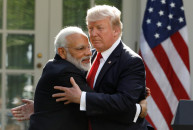Why Pakistan, India must forge strategic climate partnership
Much has already been written urging India-Pakistan cooperation on these shared risks

When Lahore and Delhi choke under the same winter smog and their northern mountains groan under cloudbursts, the border briefly disappears, only for politics to draw it again the next day. In 2025, this reality became painfully clear. Record rains and landslides killed hundreds in both India and Pakistan, breaking rainfall records and sweeping away homes and roads. Glacial lake bursts in Uttarakhand and Gilgit-Baltistan destroyed villages and bridges. Soon after, fierce windstorms followed across both countries which killed more people and damaged homes, while rivers swelled and flood warnings crossed borders. These are not separate events. They are part of one connected system that is growing more dangerous as the planet warms.
Much has already been written urging India-Pakistan cooperation on these shared risks: air quality, floods, droughts and glacier melt. Analysts have spelled out practical entry points from joint smog abatement to data-sharing and even sketched out the institutional pairs that could lead it: TERI with Pakistan's EPA, or universities and think-tanks on both sides working on comparable protocols for emissions and monitoring. Yet, despite regular calls for "regional climate diplomacy", implementation remains thin, and the winter air continues to thicken over both Punjabs. The literature is right on the "what"; it underplays the "why not", the security incentives and veto points that keep sensible ideas on paper.
Climate is already a security story in South Asia. In April 2025, New Delhi's suspension of the Indus Waters Treaty dragged water into the centre of coercive statecraft. Whether the suspension endures or evolves, the message is unmistakable: in a hotter, more volatile hydrology, water politics can move quickly from technical to existential. Meanwhile, glacial lake outburst floods destroying homes, power lines and roads near the border are kinetic threats, not conceptual; and that can easily be misread through a military lens when they traverse borders and disable critical infrastructure. Treating climate as apolitical "cooperation" underestimates how directly it now touches deterrence, crisis management and public order.
The global context makes this even more urgent. China is now the leader in green technology and climate finance. Both India and Pakistan depend on Chinese technology for renewable energy and infrastructure. Meanwhile, the Trump administration's trade policies have shaken old alliances and created uncertainty in Asia. In this environment, a climate partnership between India and Pakistan is not just about goodwill, but a way to protect both countries from external shocks and internal crises.
So, what should a Climate Strategic Partnership do differently from what past essays and policy notes have proposed? First, place security externalities at the core: a shared, de politicised early warning and incident notification arrangement for floods, heat emergencies and suspected glacial outbursts would reduce the risk of miscalculation when infrastructure fails and communities move under duress. Second, upgrade credible data-sharing: a joint observatory on glaciers, river flows and winter smog, with synchronised protocols and mirrored sensors on both sides, would make numbers harder to dispute and easier to act upon. Finally, take joint positions at COP and MDB boards to crowd in climate finance for cross border adaptation in Indus and Himalayan hotspots, moving beyond the episodic, disaster by disaster appeals that currently dominate the news cycle.
The gap in the conversation is not a lack of ideas; it is the failure to translate environmental common sense into strategic logic. A climate partnership that treats risk reduction as a shared security dividend will not solve older disputes, but it can reduce the chances of new disasters turning into crises. It's not just about saving the environment; it is about saving lives, economies and stability.
In a time when trade is uncertain and climate is fragile, this is the most practical step both countries can take. If not now, when?















COMMENTS
Comments are moderated and generally will be posted if they are on-topic and not abusive.
For more information, please see our Comments FAQ